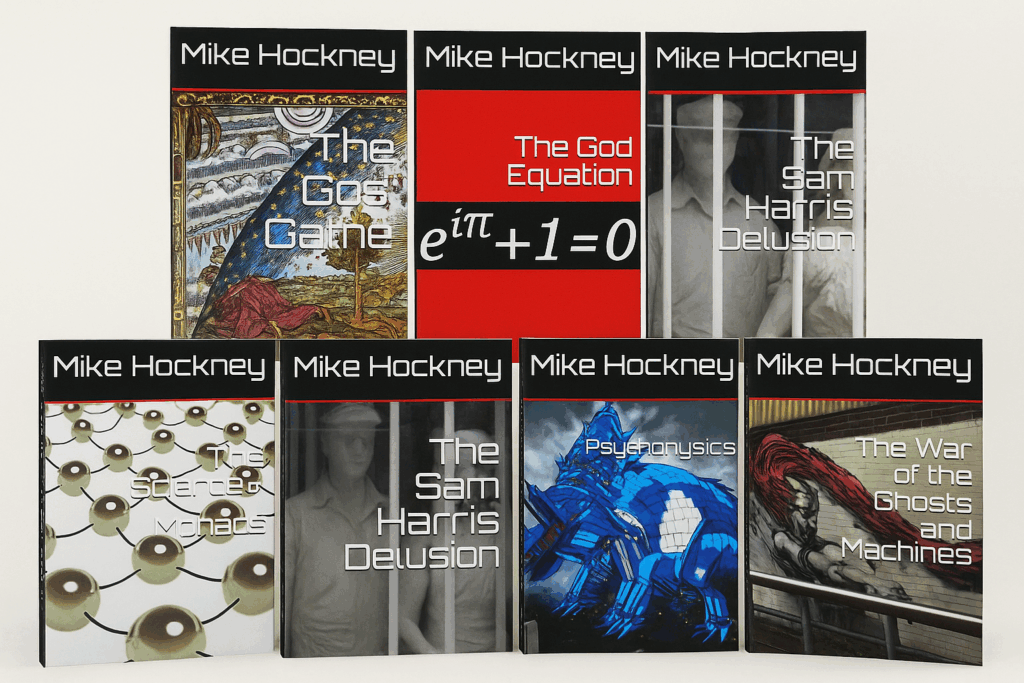It started as fiction. Or at least, I thought it did.
Back in 2014 while working on my sci-phi trilogy as blend of science, philosophy, and speculative storytelling, I dove deep into a strange corner of the internet: a web of pseudonyms, esoteric PDFs, and grand philosophical manifestos by a supposed collective writing under the names Mike Hockney, Adam Weishaupt, and Michael Faust. Their writings claimed to reveal coded truths hidden in plain sight.
I didn’t take them literally; I used them as fuel for imagination.
From coded myths to the Orb in our eyes
Their coded fictions like The Armageddon Conspiracy, Prohibition A, and The Last Bling King were wrapped in myth and symbolism. Alongside those works, they also published The God Series, a collection of non-fiction philosophical books exploring mathematics, consciousness, and the metaphysical nature of reality.

These authors said they were Illuminists. Not the pop-culture caricature with pyramids and pop stars, but a secretive lineage tracing back to Pythagoras—the so-called first Grandmaster of a rational order of light. In their version, the (Pythagorean) “Illuminati” are not shadowy elites; they’re the antidote to them. Their mission: liberation through knowledge.
They also spoke of three great secrets; two false and one true. The first two are so compelling that seekers might spend their lives chasing them. The third is real, hidden in plain sight. We don’t know what any of these three are, but they claim they’re encoded in ancient and more modern works alike: from the legend of King Arthur to the Voynich Manuscript.
More on those possible three secrets, though, in a separate post.
The book that never came out
Among their rumored works was a mysterious title called The Soul Camera. It was said to be too dangerous to publish, or perhaps never truly written at all—a piece of meta-fiction designed to stir curiosity. Its premise: a secret society possessing a device capable of seeing the human soul—of distinguishing good from evil through some unfathomable resonance.
At the time, it felt like the perfect metaphor. A moral MRI.
Was it literal? Of course not. Or so I thought.
Fast forward a decade.
Last week, someone sent me a link to a Forbes article about Worldcoin—Sam Altman’s global identity project. The one with the Orb: a gleaming silver sphere that scans your iris to verify you’re human.
I stared at that photo and froze.

There it was—at least the closest real-world analog to that old metaphor.
For balance: the project has faced privacy and regulatory scrutiny (for example, Hong Kong’s privacy regulator ordered it to cease operations there in 2024), which only heightens the stakes of what follows.
When the Orb looks back
Let’s strip away the mysticism for a second.
The Orb scans your iris and converts it into a biometric hash (an “iris code”) to issue a privacy-preserving World ID. By default, Worldcoin says raw images are deleted after processing; the credential itself can be used with on-chain systems, but your iris image isn’t posted to a blockchain.
“Proof of personhood,” they call it. In an age of AI deepfakes, that sounds like progress. But connect a persistent digital ID to your conversations, behaviors, tone, and prompts—and you have something else entirely.
Now imagine coupling that orb-scanned ID with your OpenAI account. For clarity: OpenAI and Worldcoin are separate entities, and there is no public, announced integration between ChatGPT accounts and World ID. What follows is a thought experiment about what could happen if persistent identity were ever linked to rich behavioral data.
Your prompts, your voice samples, your images, your emotional fingerprints. Every late-night query. Every unfiltered thought.
If a short personality test with only 30 statements can produce a surprisingly accurate psychological profile, what could a 30-thousand-prompt chat history reveal about your soul? At that point, fiction collapses into feedback loop—if those data streams were ever linked.
The Orb is the Soul Camera.
The age of algorithmic morality
I’m not saying there’s an evil cabal behind it.
I’m saying something subtler—and more unnerving.
What happens when your digital reflection begins to inform moral judgment? When algorithms classify “intent” not from a courtroom but from your search terms, tone, or phrasing? We’re already halfway there. Spam filters judge our sincerity. Recommendation engines infer our desires. Sentiment analysis predicts our moods.
Evil and good aren’t binary—they’re data points on a behavioral spectrum.
And we’re training the machines to grade them.
In Person of Interest, a show I once loved, an omniscient AI scanned the world’s cameras to predict crimes before they happened. The scary part wasn’t its surveillance—it was its moral compass, silently shaped by whoever built it.
Now, take the Orb as a concept, add frontier AI models, sprinkle in the data streams of Google, Apple, and Meta—and you can imagine a distributed Soul Camera beginning to hum in the background.
The devil’s no longer in the details, he’s in the data.
So… did we just find the Soul Camera?
Maybe. Maybe it’s silly. Maybe it’s profound.
Maybe fiction was the training data all along.
But look closely: a silver sphere that looks into your eyes, maps your essence, and anchors your being in the cloud.
They call it the Orb.
Some might call it The Soul Camera.
So perhaps it is prime time for …

What's on your mind?